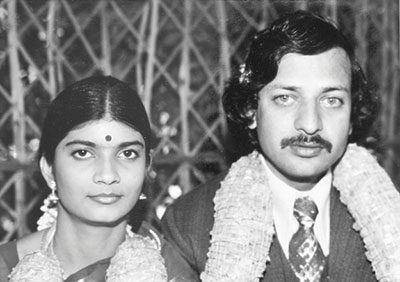
The silk saris that Radha Jagannathan wears while teaching students at Rutgers University are vibrant in color and flow gently around her small frame, a fitting complement to her soft voice and genial personality. On autumn Saturdays, her attire is equally vibrant—but in the form of a bright red Scarlet Knights sweatshirt. “I’ve become a very passionate football fan,” says Jagannathan, 50, who always wears a bindi—the bright red dot on her forehead—but swaps her traditional Indian raiment for jeans on game day. “I look completely different and I get loud—my students are often startled.”
The dichotomy between her everyday look, which closely follows her Hindu and South Indian heritage, and her bleachers garb, reflects the two worlds she has come to know—one in central New Jersey and one 8,000 miles away in what she describes as “a small orthodox town” in southern India.
Jagannathan moved to New Jersey shortly after she wed her husband of nearly 30 years, Chetlur, in an arranged marriage when she was 19. The pairing was perfect. “We just clicked,” she says. But her one stipulation—that she wouldn’t move far away from her family—was not to be met. In March 1981, Chet moved to the United States, where members of his family had already settled, and established himself in New Jersey so that he could sponsor Radha, who followed that May. The couple can be considered early immigrants from India—the influx spiked in the 1990s, when the Indian population in the United States grew by 130 percent. New Jersey has the third largest Indian-American population in the country, with more than 250,000 residents.
The Jagannathans first lived in Berkeley Heights, then Edison, Somerset, and, for the last twelve years, Belle Mead. They have two children: Krishna, 25, a Rutgers graduate who works in environmental engineering; and Meera, 19, who is studying at the University of North Carolina. Chet, 57, works in information technology, and Radha followed an unexpected path to become an urban planning and policy professor at Rutgers and a Fulbright Scholar. She started at an engineering company in New Providence ten days after moving to the United States, and initially struggled with American jargon. “My boss said something to me, and I didn’t understand—the English spoken here was so different from what I was used to.” So she started watching shows such as Gilligan’s Island and The Partridge Family to adjust to the language. “It was hilarious,” she says. But it worked.
Jagannathan took a secretarial job at Rutgers, moving up the ladder to become a research assistant and, eventually, associate professor. During that time, she completed her bachelor’s degree, attained her master’s degree at Rutgers (she had a three-year degree from the University of Delhi), and earned her doctorate at Princeton focusing on public and international affairs with an expertise that government agencies now draw on for program evaluations.
Born into a family with modest economic means (they slept on the floor of a small room and hallway), though they were upper caste in India, Jagannathan’s success is something she says could only have been achieved in the United States. “God tells you to use your brain to the fullest potential,” she says. “I worked hard, and I will always be grateful for that opportunity.”
Her achievements also reflect the broader Indian-American population; according to the U.S. Census of those 25 and older, 32 percent of Indian-Americans have attained a bachelor’s degree, and 36 percent have attained a graduate or professional degree—compared with 17 percent and 10 percent of the total population. “I’m proud of what we have done in America,” Jagannathan says of Indian immigrants. “We’ve blended in, and we’ve pitched in and, I think, made the country better.”
Blending in does not mean abandoning traditions. Though Jagannathan says her children are “fully American, to the core,” the family still strictly follows many South Indian customs and celebrates festivals such as Navrathri, which brings 25 families into the Jagannathan home over the course of a September weekend. In addition to having most of her husband’s extended family settled in New Jersey, Jagannathan found a tight-knit South Indian community in the Edison, South Brunswick, and New Brunswick areas, with whom she remains close.
Though the history of Indian immigration in New Jersey is rocky—a series of racial incidents against Indian-Americans panicked Jersey City in the 1980s—Jagannathan says she has never felt discriminated against. “If anything, people are genuinely interested and complimentary.”
For that and so much else, she is grateful. But India will always be her home. “You can never forget your roots, and in my heart, I’m still Indian,” she says. “I probably feel about 80 percent Indian and 20 percent American. But I take the best of both worlds.”
In Jersey, that includes football.
